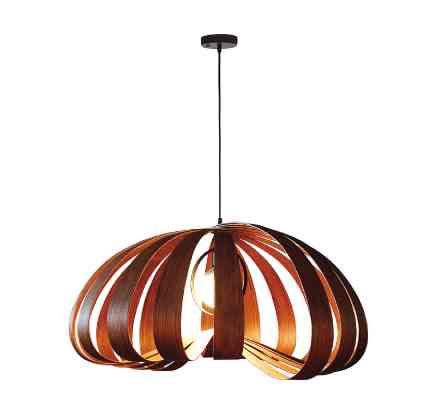Because of the stress of contemporary living, homes are designed as sanctuaries where inhabitants can chill. Interiors must be soothing and seamless.
Filipino furniture and lighting maker Triboa Bay Living has been addressing this trend of calming spaces. Its furniture pieces highlight the natural textures of wood for an organic feel. Softer shapes cradle the body, and lighting designs are inspired by nature.
Rough luxe is indicated in the raw finishes of the tables and cabinets, showing the beauty of the wood’s textures and grains.
Lamps have relaxed and unstructured shapes, a series of folded strips turn them into concentric circles, onion bulbs and lilies. Folding-style, slatted wooden chairs, tables and shelves offer space-saving solutions for compact homes.

The aesthetics of Triboa Bay Living has evolved from its traditional form-bent wood and woven-cane furniture. Under the helm of Randolph Viray, a third-generation furniture manufacturer, the designs exude an understated and quiet sensibility.
The style is inspired by history, nature, Pampanga craftsmanship, and judicious use of available wood. The designs focus on the rhythm of lines and circles and the intrinsic beauty of organic materials.
Viray grew up in Betis, the town famous for its woodcarving and classical furniture. His grandfather exposed him to factory production, while his mother got him involved in retail.
After graduating from De La Salle University with a degree in political science, he helped manage the family business.
Bentwood chair
One day, at a machine shop, he saw a bentwood chair, designed by Michael Thonet, a German-Austrian who invented bentwood furniture. The chair was characterized by an X-back, curved pieces of wood on a back frame, and woven cane matting on the seat.
The machine shop owner pointed to a place in San Fernando which repaired old furniture from ancestral homes. Viray went to the source and bought a Thonet repro for design inspiration.
At a furniture exhibit in SM North Edsa, Viray sold his X-back chair patterned after Thonet’s iconic Vienna chair, famous for its airy back and bent wood frame. He started getting orders.
In the mid-’90s, a buyer made a bulk order of bentwood chairs that were later exported to the Netherlands. When Viray joined the Center for International Trade Expositions and Missions fair, he got more foreign buyers.
The bentwood chairs were produced by a supplier, while his family’s factory in Betis did the finishing in oak. However, working with subcontractors posed challenges in quality control. Viray decided to use the family factory for production and substituted tanguile for the frame.
Viray expanded the furniture line that was characterized by clean, simple lines, drawing attention to the surface treatment characterized by closed grains and dark stains.
“The look was not rustic, more like a refined country style,” says Viray. “To this day, all my pieces are slim, easy on the eyes.”
In 2000, Viray collaborated with designer Eric Paras who modernized the collection. He also shifted from the endangered tanguile to gmelina. Its tree grows fast and produces pale, coarse and wavy grained wood whose weight ranges from light to medium. He also used ash and light walnut.
Today, Viray has his own Vivere Lifestyles Company, which has a factory in Angeles City. Silhouettes are streamlined. His furniture and lighting collection, Triboa Bay Living, is named after the popular destination in Subic where his family spends the holidays.
Salvaged, repurposed
Its classic chair is made of gmelina with solihiya or a woven seat. The Milton dining table consists of salvaged wood from ancestral homes. The Villa cabinet is built with repurposed wood, while the inside shelving is painted light green for contrast. A lovers’ armchair can be pulled out to become a chaise longue.
A wall installation of turned squares resembles what he calls a “depthless matrix.” There’s the classic influence in a chandelier, made of the upturned pieces of gmelina with fabric shades. The modern direction is reflected in the irregular-shape, low walnut coffee tables with steel legs.
The company also collaborated with Dutch designer Robert van Embricqs for the Rising Chair, several strips of teakwood unfolded to reveal an organic-shape seater.
Viray’s Staircase lamp has become a popular design. The base was derived from the antique winding staircase. His favorite lamp is a hanging orb fixture which reminds him of sunset. It’s made of concentric corrugated strips of veneer. “The rings look as if they are floating,” he says.
Viray underscores the importance of branding. For so long, foreign companies put their brand on Philippine-made products. The entrepreneur insists on Triboa Bay Living as a Filipino brand.
“Big buyers dictated on you,” he says. “Small buyers could accept our prices with small orders like six pieces instead of 50. They know we don’t serve their competitors. We’ve come a long way. Foreign buyers are beginning to see the value of Philippine-made products. That’s the benefit of branding—you are obliged to stay on your toes and keep your styles fresh and exciting.” —CONTRIBUTED
Triboa Bay Living’s main showroom is at LRI Design Plaza, 210 Nicanor Garcia St., Bel-Air II, Makati; tel. 8951772, 8957949